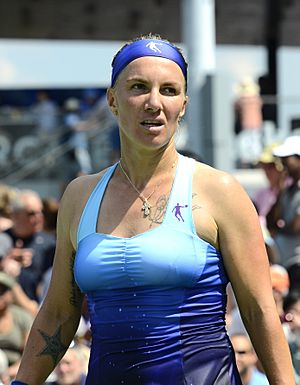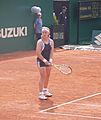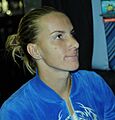Svetlana Kuznetsova facts for kids

Kuznetsova at the 2014 US Open
|
|
| Country (sports) | |
|---|---|
| Residence | Moscow, Russia |
| Born | 27 June 1985 Leningrad, Russian SFSR, Soviet Union |
| Height | 1.74 m (5 ft 9 in) |
| Turned pro | 2000 |
| Retired | 2021 |
| Plays | Right-handed (two-handed backhand) |
| Coach | Gustavo Marcaccio |
| Prize money | $25,816,890
|
| Singles | |
| Career record | 670–348 (65.82%) |
| Career titles | 18 |
| Highest ranking | No. 2 (10 September 2007) |
| Grand Slam singles results | |
| Australian Open | QF (2005, 2009, 2013) |
| French Open | W (2009) |
| Wimbledon | QF (2003, 2005, 2007, 2017) |
| US Open | W (2004) |
| Other tournaments | |
| Tour Finals | SF (2016) |
| Olympic Games | QF (2004) |
| Doubles | |
| Career record | 259–135 (65.74%) |
| Career titles | 16 |
| Highest ranking | No. 3 (7 June 2004) |
| Grand Slam doubles results | |
| Australian Open | W (2005, 2012) |
| French Open | F (2004) |
| Wimbledon | F (2005) |
| US Open | F (2003, 2004) |
| Other doubles tournaments | |
| Tour Finals | SF (2003, 2004) |
| Olympic Games | QF (2008, 2016) |
| Mixed doubles | |
| Career record | 4–4 (50%) |
| Grand Slam mixed doubles results | |
| Australian Open | 1R (2003, 2014) |
| French Open | 2R (2003) |
| Wimbledon | QF (2003) |
| Team competitions | |
| Fed Cup | W (2004, 2007, 2008) Record 27–13 |
Svetlana Aleksandrovna Kuznetsova (born on June 27, 1985) is a Russian former professional tennis player. She was once ranked as high as world No. 2 in singles and world No. 3 in doubles by the WTA. Svetlana won 18 singles and 16 doubles titles during her career. This includes two major singles titles at the 2004 US Open and 2009 French Open. She also won two major doubles titles at the 2005 and 2012 Australian Opens.
Svetlana first played in a WTA Tour event in 2001. Her first big singles win was at the 2004 US Open, where she beat fellow Russian Elena Dementieva. This made her the third Russian woman to win a major tennis tournament. Her second major singles title came at the 2009 French Open, where she defeated Dinara Safina in the final. She also reached the finals of the 2006 French Open and the 2007 US Open, both times losing to Justine Henin. These strong performances helped her reach her highest singles ranking of world No. 2. Svetlana retired from professional tennis in 2021.
Svetlana was also very good at doubles. She won her first five WTA doubles titles with Arantxa Sánchez Vicario. Later, partnering with Elena Likhovtseva, she reached No. 3 in doubles in 2004. She won the Australian Open doubles title twice: in 2005 with Alicia Molik and in 2012 with Vera Zvonareva.
Contents
Early Life and Tennis Beginnings
Svetlana Kuznetsova was born in Leningrad, which is now called St. Petersburg, Russia. Her family is very athletic! Her father, Aleksandr Kuznetsov, coached many Olympic and world cycling champions. Her mother, Galina Tsareva, was a six-time world champion in cycling and set 20 world records. Svetlana's brother, Nikolay Kuznetsov, won a silver medal in cycling at the 1996 Summer Olympics in Atlanta.
Even with all the cycling around her, Svetlana was always interested in tennis. She loved watching tennis from a young age, especially men's matches. She started playing tennis when she was seven. When she was 13, she moved to Spain to get better training and coaching. While living there, she learned to speak Spanish very well.
Career Highlights
Starting Out in Tennis (2000-2002)
Svetlana started playing in professional tournaments in 2000. She won her first title on the ITF Circuit in April 2001. She made her first appearances in big WTA Tour events later that year.
In 2002, Svetlana played in the main part of a Grand Slam tournament for the first time at the 2002 Australian Open. She reached the second round there. In August 2002, she won her first WTA singles title at the Nordic Light Open in Finland. She beat world No. 24 Patty Schnyder along the way. This win helped her enter the top 100 players for the first time. Later that year, she won another title in Bali, Indonesia. She also started winning doubles titles, teaming up with Arantxa Sánchez Vicario. Svetlana finished 2002 ranked No. 43 in singles.
First Grand Slam Quarterfinal (2003)
In 2003, Svetlana reached her first Grand Slam quarterfinal at Wimbledon. She beat Maria Sharapova in the fourth round before losing to Justine Henin. In doubles, she teamed up with Martina Navratilova and reached her first Grand Slam final at the US Open, but they lost. She also won a doubles title in Leipzig, Germany, with Navratilova. Svetlana ended 2003 ranked No. 36.
Winning the US Open (2004)
The year 2004 was a huge one for Svetlana. At the Australian Open, she reached the third round in singles and her second major doubles final with Elena Likhovtseva. She then had big wins in Dubai and Doha, beating top players like Venus Williams and Ai Sugiyama.
Svetlana won her third singles title at the Eastbourne International. At the US Open, she was seeded ninth. She defeated Lindsay Davenport in the semifinals, ending Davenport's 22-match winning streak. In the final, Svetlana beat Elena Dementieva to win her first Grand Slam singles title! She was the first Russian woman to win the US Open. This success helped her reach world No. 5 in singles and No. 3 in doubles.
Back to Top Form (2006)
After a challenging 2005, Svetlana returned to strong form in 2006. At the Miami Open, she defeated world No. 1 Amélie Mauresmo in the semifinals and then beat Maria Sharapova in the final. This was her first major title in 18 months and brought her back into the top ten players.
She reached her second Grand Slam final at the French Open, but lost to Justine Henin. Svetlana also won two more titles that year in Bali and Beijing, beating Mauresmo again in the China Open final. She finished 2006 ranked world No. 4.
Reaching World No. 2 (2007)
Svetlana continued her success in 2007. She reached several finals, including in Doha, Indian Wells, Berlin, and Rome. She even beat world No. 1 Justine Henin for the second time in Berlin. In August, she won her first title of the year in New Haven.
At the US Open, Svetlana reached her third Grand Slam final, but lost to Henin. After this tournament, she reached her career-high singles ranking of world No. 2. She finished 2007 as the highest-ranked Russian player.
French Open Champion (2009)
After a year without a title in 2008, Svetlana started 2009 strong. She won her first title of the year at the Porsche Grand Prix in Stuttgart, beating world No. 1 Dinara Safina. The next week, she reached another final in Rome, again losing to Safina.
At the French Open, Svetlana defeated Serena Williams in the quarterfinals. She then beat Dinara Safina in the final to win her second Grand Slam title! This was a huge achievement. She later won the China Open in Beijing. Svetlana finished 2009 ranked world No. 3.
Later Career and Injuries (2010-2021)
From 2010 onwards, Svetlana faced more challenges with her form and injuries. She won the San Diego Open in 2010. In 2011, she played in the longest recorded women's Grand Slam match in the Open Era, lasting 4 hours and 44 minutes, against Francesca Schiavone. She lost that match in a very close third set.
In 2012, she won her second Grand Slam doubles title at the Australian Open with Vera Zvonareva. However, she also started dealing with more injuries, which caused her to miss the US Open for the first time since 2002.
Svetlana made a good comeback in 2013, reaching the quarterfinals of the Australian Open and French Open. In 2014, she won her first singles title in almost four years at the Washington Open. In 2015, she reached a big final at the Madrid Open and won the Kremlin Cup.
In 2016, Svetlana reached the final of the Miami Open, where she beat Serena Williams. This win helped her return to the top ten rankings for the first time since 2010. She also reached the semifinals of the WTA Finals.
Her last few years were affected by injuries. She won the Citi Open again in 2018, extending her perfect record at that tournament. In 2019, she reached the final of the Western & Southern Open as a wildcard, showing she could still compete at the highest level. Svetlana officially retired from tennis in 2021.
Playing Style
Svetlana Kuznetsova plays with her right hand and uses a two-handed backhand. She is known as an "all-around" player, meaning she can play well from all parts of the court. Experts have described her as one of the most technically complete players.
She is very fast on the court and has a powerful forehand shot with a lot of topspin. She is also good at hitting effective volley winners close to the net. Svetlana can change the spin, speed, and height of her shots, which makes her game hard for opponents to predict. Her main strengths are her powerful and accurate forehand, strong topspin, solid serve, and great speed.
Career Statistics
Svetlana Kuznetsova had a long and successful career. Here are some of her Grand Slam singles results:
Grand Slam Singles Performance
| Tournament | 2002 | 2003 | 2004 | 2005 | 2006 | 2007 | 2008 | 2009 | 2010 | 2011 | 2012 | 2013 | 2014 | 2015 | 2016 | 2017 | 2018 | 2019 | 2020 | 2021 | SR | W–L |
|---|---|---|---|---|---|---|---|---|---|---|---|---|---|---|---|---|---|---|---|---|---|---|
| Australian Open | 2R | 1R | 3R | QF | 4R | 4R | 3R | QF | 4R | 4R | 3R | QF | 1R | 1R | 2R | 4R | A | A | 2R | 2R | 0 / 18 | 37–18 |
| French Open | Q2 | 1R | 4R | 4R | F | QF | SF | W | 3R | QF | 4R | QF | QF | 2R | 4R | 4R | 1R | 1R | 1R | 1R | 1 / 19 | 52–18 |
| Wimbledon | Q2 | QF | 1R | QF | 3R | QF | 4R | 3R | 2R | 3R | 1R | A | 1R | 2R | 4R | QF | 1R | 1R | NH | 1R | 0 / 17 | 30–17 |
| US Open | 3R | 3R | W | 1R | 4R | F | 3R | 4R | 4R | 4R | A | 3R | 1R | 1R | 2R | 2R | 1R | 1R | A | A | 1 / 17 | 35–16 |
| Win–loss | 3–2 | 6–4 | 12–3 | 11–4 | 14–4 | 17–4 | 12–4 | 16–3 | 9–4 | 12–4 | 5–3 | 10–3 | 4–4 | 2–4 | 8–4 | 11–4 | 0–3 | 0–3 | 1–2 | 1–3 | 2 / 71 | 154–69 |
Grand Slam Finals: Singles and Doubles
Svetlana played in four Grand Slam singles finals, winning two of them. She also reached seven Grand Slam doubles finals, winning two.
Singles: 4 (2 titles, 2 runner–ups)
| Result | Year | Championship | Surface | Opponent | Score |
|---|---|---|---|---|---|
| Win | 2004 | US Open | Hard | 6–3, 7–5 | |
| Loss | 2006 | French Open | Clay | 4–6, 4–6 | |
| Loss | 2007 | US Open | Hard | 1–6, 3–6 | |
| Win | 2009 | French Open | Clay | 6–4, 6–2 |
Doubles: 7 (2 titles, 5 runner–ups)
| Result | Year | Championship | Surface | Partner | Opponent | Score |
|---|---|---|---|---|---|---|
| Loss | 2003 | US Open | Hard |
|
2–6, 3–6 | |
| Loss | 2004 | Australian Open | Hard | 4–6, 3–6 | ||
| Loss | 2004 | French Open | Clay | 0–6, 3–6 | ||
| Loss | 2004 | US Open | Hard | 4–6, 5–7 | ||
| Win | 2005 | Australian Open | Hard |
|
6–3, 6–4 | |
| Loss | 2005 | Wimbledon | Grass |
|
2–6, 1–6 | |
| Win | 2012 | Australian Open | Hard | 5–7, 6–4, 6–3 |
Awards and Recognitions
Svetlana Kuznetsova received many awards throughout her career:
- 2001: Russian Cup (Newcomer of the Year)
- 2002: WTA Awards – Most Impressive Newcomer (won), Russian Cup (Success of the Year)
- 2004: Russian Cup (Team of the Year)
- 2005: Nominated for Laureus World Newcomer of the Year and Best Female Tennis Player ESPY Award
- 2006: WTA Awards – Diamond Aces (won)
- 2007: Russian Cup (Team of the Year)
- 2008: Russian Cup (Team of the Year)
- 2009: Order of Merit for the Fatherland, 2nd class; Nominated for Best Female Tennis Player ESPY Award
- 2016: Russian Tennis Hall of Fame (Best Contemporary Tennis Player), Russian Cup (Best Tennis Player)
Notable Records
Svetlana holds some impressive records in tennis:
- Longest Women's Grand Slam Match: At the 2011 Australian Open, she played the longest women's singles match in a Grand Slam in the Open Era. It lasted 4 hours and 44 minutes against Francesca Schiavone.
- Longest Fed Cup Singles Match: In the 2016 Fed Cup, she played the longest Fed Cup women's singles match, lasting 4 hours, against Richèl Hogenkamp.
Images for kids
See also
 In Spanish: Svetlana Kuznetsova para niños
In Spanish: Svetlana Kuznetsova para niños







